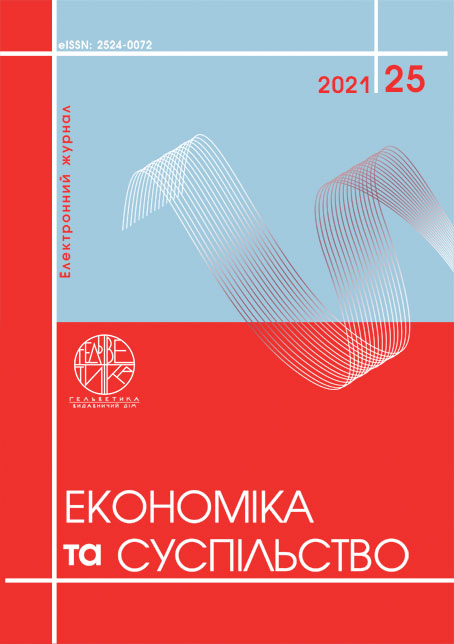FLOW DIAGRAM OF FORMING OF STRATEGIC CASE FINANCIAL RESOURCES FRAME
Abstract
Due to the global coronavirus pandemic, there is a reduction in production, declining purchasing power, rising unemployment. Enterprises, with sufficient material, human, time and information resources, move to a new level of management of economic activity, are restructured into less vulnerable forms of economic activity, reorganization or association with other economic entities. This is achieved through proper financial management, which includes the management of assets, working capital, expenses, profits. Therefore, there is a need to create a management model that would satisfy the activities with the necessary amount of financial resources to operate in such a crisis situation. The proposed scheme of forming a model of financial resources management should take into account the dynamics of macroeconomic processes, trends in domestic financial markets, opportunities for diversification, etc., to achieve positive results. The scheme of financial resources management, taking into account financial opportunities, objectively assessing the nature of internal and external factors, should subordinate all components in the overall planning of economic development and aim to optimize financial activities, profits and market capitalization. Financial resources management is characterized as a multi-component oriented model of actions, measures and algorithms required to achieve long-term goals in the overall development policy for the formation and implementation of financial and resource potential. Given the above, the scheme of the financial management model should be based on the following interdependent blocks: purpose and objectives; levels of implementation; external and internal factors of formation; limitation; tools and methods of implementation; effectiveness.
References
Аксель З. Дослідження зв'язку стратегічного і тактичного планування. Журнал європейської економіки. 2006. № 4. С. 464–480.
Васильєва Т.А., Афанасьєва О.Б. Держава, підприємства та банки в системі антикризового управління : монографія. Суми : Вид-во «Ярославна», 2013. 488 с.
Наслідки епідемії COVID-19 та карантинних заходів для провідних секторів економіки України. Дослідження за результатами глибинних інтерв’ю з власниками та топ-менеджерами українських компаній. Київ-Харків : Видавець О.А. Мірошниченко, 2020. 188 с.
Овсійчук М.Ф., Сидельникова Л.Б. Фінансовий менеджмент: методи інвестування капіталу. Київ : Либідь, 2008. 536 с.
Ортіна Г.В. Методологічні концепції визначення стратегічного управління підприємством. Ефективна економіка. 2010. № 4. URL: http://www.economy.nayka.com.ua/?op=1&z=197&sa=U&ved=0CBMQFjAAahUKEwji7c-ejL7IAhVinnIKHalWBjs&usg=AFQjCNEmsWDwB55hI5GoPD0lJVPlMkTxlw
Поддерьогін А.М. Фінанси підприємств. Київ : КНЕУ, 2004. 546 c.
Терещенко О.О. Антикризове фінансове управління на підприємстві : монографія. Київ : КНЕУ, 2004. 268 с.
Формування нового світового економічного порядку [Текст] : аналіт. зап. за матер. Чотирнадцятої міжнар. наук. конф., Анталія, 29 верес.-6 жовт. 2009 р. / уклад. Сергій Юрій [та ін.]. Вісник Тернопільського національного економічного університету. 2009. № 4. С. 107–120.
Шевченко Н.І. Реорганізація як спосіб припинення господарських товариств : монографія. Київ : Вид-во «Ліра-К», 2014. 216 с.
Heidari-Robinson S. ReOrg: How to Get It Right / S. Heidari-Robinson, S. Heywood. Boston : Harvard Business School Pr (US), 2016. 252 p.
Axel Z. (2006) Research of the connection of strategic and tactical planning. Journal of European Economics. № 4. P. 464–480.
Vasilieva T.A., Afanasyeva O.B. (2013) State, enterprises and banks in the system of crisis management: a monograph. Sumy: Publishing House "Yaroslavna", 488 p.
Consequences of the COVID-19 epidemic and quarantine measures for the leading sectors of the Ukrainian economy. Research based on the results of in-depth interviews with owners and top managers of Ukrainian companies. Kyiv-Kharkiv: Publisher О.А. Miroshnichenko, 2020. 188 p.
Ovsiychuk M.F., Sidelnikova L.B. (2004) Financial management: methods of capital investment. Kyiv: Libil, 536 р.
Ortina G.V. (2010) Methodological concepts of definition of strategic management of the enterprise. Effective Economics. № 4. Access mode: http://www.economy.nayka.com.ua/?op=1&z=197&sa=U&ved=0CBMQFjAAahUKEwji7c-ejL7IAhVinnIKHalWBjs&usg=AFQjCNEmsWDwB55hI5GoPD0lJVPlMkTxlw
Podderyogin A.M. (2004) Finance of enterprises. Kyiv: KNЕU, 546 р.
Tereshchenko O.O. (2004) Anti-crisis financial management at the enterprise: monograph. Kyiv: KNEU, 268 p.
The formation of a new world economic order [Text]: analyst. zap. for mater. Fourteenth International. Science. Conf., Antalya, September 29-October 6. 2009 / ed. Serhiy Yuriy [etc.]. Bulletin of Ternopil National Economic University. 2009. № 4. P. 107–120.
Shevchenko N.I. (2014) Reorganization as a way of terminating business associations: monograph. Kyiv: Lira-K Publishing House, 216 p.
Heidari-Robinson, S., & Heywood, S. (2016) ReOrg: How to Get It Right. Boston: Harvard Business School Pr (US), 252 p.


